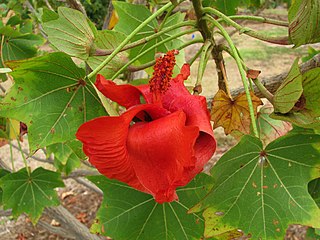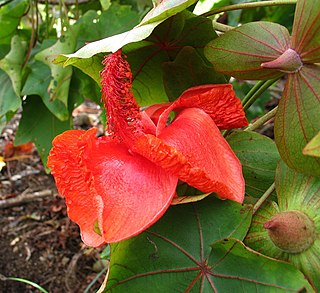
Kokia cookei is a small, deciduous tree commonly known as the kokiʻo, Molokaʻi treecotton, Cooke's kokiʻo, or Molokaʻi kokiʻo.
Crudia lanceolata is a species of plant in the family Fabaceae. It is a tree found in Peninsular Malaysia and Thailand. It is threatened by habitat loss.
Lecythis lanceolata is a species of woody plant in the family Lecythidaceae of the order Ericales. It is endemic to the Atlantic Forest ecoregion in southeast Brazil, where is known as sapucaia-mirim. It was described by Jean Louis Marie Poiret in 1804.

Kokia drynarioides, commonly known as Hawaiian tree cotton, is a species of flowering plant in the mallow family, Malvaceae, that is endemic to the Big Island of Hawaii. It inhabits dry forests at elevations of 455–1,915 m (1,493–6,283 ft). Associated plants include ʻāheahea, ʻaʻaliʻi, hala pepe, wiliwili, uhiuhi, kōlea, ʻaiea, kuluʻī, ʻālaʻa, ʻohe kukuluāeʻo, māmane, and maua. It is threatened by habitat loss and competition with invasive species, such as Fountain Grass.
Kokia kauaiensis, the Kauai treecotton or Kauaʻi Kokiʻo, is a species of flowering plant in the mallow family, Malvaceae, that is endemic to Kauaʻi, Hawaii.
Dypsis lanceolata is a species of flowering plant in the family Arecaceae. It is found only in Comoros.
Aporosa lanceolata is a species of plant in the family Phyllanthaceae. It is endemic to Sri Lanka.
Buchanania lanceolata is a species of plant in the family Anacardiaceae. It is endemic to India.
Gluta lanceolata is a species of plant in the family Anacardiaceae. It is a tree endemic to Peninsular Malaysia.
Helicia rostrata is a species of plant in the family Proteaceae. It is endemic to Papua New Guinea.
Heliciopsis lanceolata is a species of plant in the family Proteaceae. It is found in Indonesia and Malaysia. It is threatened by habitat loss.

Kageneckia lanceolata is a species of plant in the family Rosaceae. It is found in Bolivia and Peru. It is threatened by habitat loss.
Meryta lanceolata is a species of plant in the family Araliaceae. It is endemic to French Polynesia.

Protea lanceolata is a species of plant in the family Proteaceae. It is endemic to the Cape Provinces of South Africa. It is threatened by habitat loss.
Roupala loxensis is a species of plant in the family Proteaceae. It is endemic to Ecuador.
Saurauia lanceolata is a species of plant in the Actinidiaceae family. It is endemic to Java in Indonesia.
Wrightia lanceolata is a species of plant in the family Apocynaceae. It is endemic to Thailand.

Kokia, with the common name treecotton, is a genus of flowering plants in the mallow family, Malvaceae.





